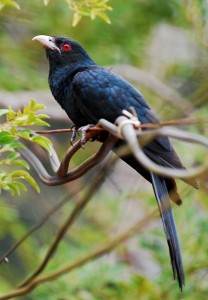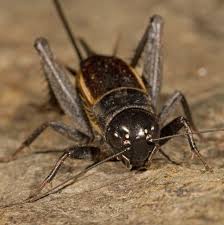We’ve covered the issue of noise pollution in class, and Max has even penned his thoughts about living near a (perpetually) loud highway, so I thought it’d be interesting to delve a little deeper into how anthropogenic noise affects animals which rely heavily on acoustic communication.
When we think of acoustic communication, many of us would probably automatically think of birds, with all their lovely (though sometimes raucous) calls (read: Asian koel).

The Asian koel – everyone’s daily alarm clock
Many species of birds alter their songs by changing the pitch (or for any physicists out there: fundamental frequency) of their songs, or choosing to use more of the high-pitched elements in their existing repertoire. In so doing, they avoid competing against (and losing to) the low-frequency vehicular noises.
Frogs are also known to change their call rates in response to traffic noise. Species with low-frequency calls, such as bullfrogs, call more often in the presence of traffic noise, presumably to increase the chances of females hearing them during a break in the traffic noise.

“Listen to my low and sexy voice… LISTEN TO IT!!!”
What about invertebrates? Crickets are a well-known example of insects that rely heavily on acoustic communication. This interesting article describes a recent study conducted on crickets, to determine how traffic noise affects cricket song. The study found that unlike birds, which alter the pitch of their calls, or bullfrogs, which call more often, the crickets actually decreased their call rates in the face of increased traffic noise! This was an unexpected finding, but the authors suggested that it could be a measure adopted to conserve energy (if you can’t beat them… don’t fight them?). It would also be a smart strategy to adopt since traffic noise is not uniform over time, so saving energy during peak hour could mean a higher chance of attracting a mate during the quieter hours.

“Is rush hour over yet?”
While I personally marvel at the variety of adaptive strategies adopted by the different species, behavioural changes can have some drawbacks. First off, not every species, or individual in a species, can change the pitch of their calls. This could be due to physiological constraints, or due to the mechanism of call production.
Second, the females of certain species have a preference for mating calls of lower frequencies (as is the case of the bullfrog), often because low-frequency calls are an honest indication of bigger-sized, and thus better quality, males. In such cases, the ability of females to perceive and locate “good quality”, or fitter, males, is diminished.
Third, competing against traffic noise is energetically costly, and could reduce fitness in males.
Taken together, traffic noise does seem to affect animal behaviour quite a bit, in species that rely heavily on acoustic communication. Another thought that occurred to me while browsing these articles was that all these studies examine how animals adapt to their local environments. What about migratory animals that rely heavily on acoustic communication (like birds)? Would they be affected by the differing levels of traffic noise in the different localities they pass along their route? Or will they be able to adapt quickly enough to the changing soundscape?
Of course, this post only touched on how the production and perception of mating calls is affected, but animals also rely on acoustic cues for many other purposes, such as foraging, caring for young, or other forms of social communication (like the alarm calls of squirrels). These are also affected by urban noise in many ways. Feel free to comment with any interesting examples that you know of!
References:
Nemeth, E., & Brumm, H. (2009). Blackbirds sing higher-pitched songs in cities: adaptation to habitat acoustics or side-effect of urbanization? Animal Behaviour, 78(3), 637–641. doi:10.1016/j.anbehav.2009.06.016
Orci, K. M., Petroczki, K., & Barta, Z. (2016). Instantaneous song modification in response to fluctuating traffic noise in the tree cricket Oecanthus pellucens. Animal Behaviour, 112, 187–194. doi:10.1016/j.anbehav.2015.12.008
Potvin, D. A., & Mulder, R. A. (2013). Immediate, independent adjustment of call pitch and amplitude in response to varying background noise by silvereyes (Zosterops lateralis). Behavioral Ecology, 24(6), 1363–1368. doi:10.1093/beheco/art075
Sun, J. W. C., & Narins, P. M. (2005). Anthropogenic sounds differentially affect amphibian call rate. Biological Conservation, 121(3), 419–427. doi:10.1016/j.biocon.2004.05.017



